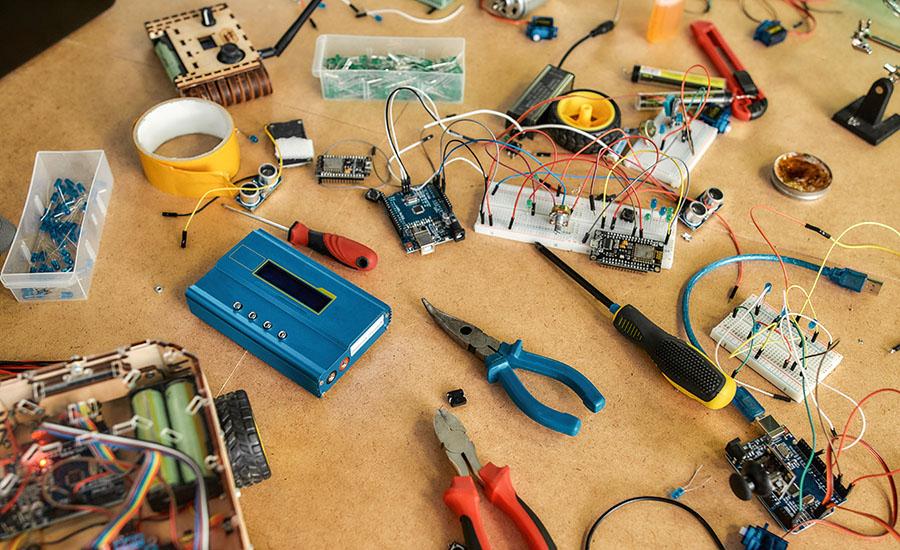Grades:
5th Grade
This is the second lesson in the series of lessons comparing how garden growing techniques determine plant growth/production. In this lesson, students will research the best types of plants to grow
Grades:
7th Grade, 8th Grade, 9th Grade
Students will experiment with stirring colors and creating effects, to learn through experimentation while creating a piece of art. The purpose of this lesson is to use visual arts to explore
Grades:
5th Grade
Students will individually construct straw rockets. Using the launcher, students will learn the concept of Newton's third law of motion: for every action, there is a equal and opposite reaction
Grades:
6th Grade, 7th Grade, 8th Grade, 9th Grade
Summary - Students will be identifying the structures and functions of plant reproductive parts. Materials - Flowers, scissors, magnifying lenses, resource materials (internet/textbook)
Grades:
6th Grade
In this 3rd and final lesson in a series of 3, students examine prior knowledge about the real-world problem of the Great Pacific Garbage Patch and apply their findings to design solutions. Students
Grades:
8th Grade
This engaging lesson is all about reverse engineering! Students will read and discuss the hook “A.I. Apocalypse”. They learn all about reverse engineering during this project as they determine a
Grades:
Kindergarten, 1st Grade, 2nd Grade
Students will learn and explain about pollination and how it helps plants to grow and reproduce. After reading about pollinators, students will collaborate and communicate effectively with their peers
Grades:
6th Grade, 7th Grade, 8th Grade
Students will learn how to construct a moving car robot and program the robot using block-based coding. They will be successful when they have coded the car robot through a maze, they created, without
Grades:
6th Grade, 7th Grade, 8th Grade
Model Building For Disaster is a 4-6 week unit in which students research natural disasters around the world and their effect on developing countries. Following their research, student teams design
Grades:
4th Grade, 5th Grade, 6th Grade, 7th Grade, 8th Grade
Classes will prepare several garden bins for planting. By using a tape measure, students take into consideration the recommended distances of seed planting described on the seed packet and the
Grades:
4th Grade
Students will learn about energy and how it relates to growing plants in this first part of a 4 part lesson. Materials needed: copy of parent signature form, student handbook. Agenda: What is Energy
Grades:
5th Grade
Power point with parts of a flower, worksheets and short quiz provided
Grades:
2nd Grade
Students will observe caterpillars and make a model of what a caterpillar looks like. Materials needed: Live caterpillars, pictures of caterpillars, marshmallows, toothpicks, pipe cleaners, rubber
Grades:
4th Grade, 5th Grade
This lesson teaches students about lines, angles, measuring and naming angles, using a protractor, and engages students by having them build a catapult and measure best angle for furthest launch.
Grades:
7th Grade
In this engaging lesson, students will use 2-3 days to build a land yacht with Lego BricQ sets. They will test different winds and angles, and then use their lab to introduce Newton's third law of
Featured
Mosquito Management
Grades:
3rd Grade, 4th Grade, 5th Grade
This lesson takes place in as classroom for one or more 60 minute class periods. The data collection portion may continue for 2+ weeks (or whatever time frame you decide). An emphasis is placed on the
Grades:
6th Grade, 7th Grade, 8th Grade
Are you ready to build?! In this hands-on lesson students build a model of a robot using LEGOs. They will discuss the advantages and disadvantages of robots and determine what task their model robot
Grades:
4th Grade
In this lesson, students will develop and use the model of a simple circuit to explain how energy is moved through electric currents. The current and voltage in circuits with 1 dry cell and 2 dry
Grades:
6th Grade
In this unit, students will study the effects of acid rain and chemically engineer an environmentally friendly solution to neutralize the acid in a simulated river contaminated by factory run-off
Grades:
5th Grade
This is the 2nd part in a 4-lesson series. This lesson is on the fins and how they work with balanced and unbalanced forces. Students will need the worksheet, the article for read and reflect, foam
Grades:
Kindergarten
Students will analyze shadows to determine how light moves and changes throughout the day.
Grades:
3rd Grade, 4th Grade, 5th Grade
Analyze and interpret data they have collected from an owl pellet dissection to answer a question. Use a dichotomous key to identify bones of prey species found in an owl pellet. List of Materials owl
Grades:
5th Grade
This hands-on lesson will help students to understand the connection between Earth's orbit around the sun and how it relates to the time of day. Students create a sundial and will trace the shadow
Grades:
6th Grade, 7th Grade
Students will be designing and building a strong house able to withstand hurricanes and tropical storms. In the lesson, students will compare their work with the actions of a character from If I Built
Featured Lesson Plans
Check out these notable lesson plans.

Grades:
6th Grade
This is the 2nd lesson in a series of 3. In this 8-week project, 6th-grade students will collaborate in small groups to create eco-friendly inventions that aim to reduce their carbon footprints and

Grades:
6th Grade
This is the 1st lesson in a series of 3. 6th-grade students will work in groups to create eco-friendly inventions that help the environment and tackle climate change. They will research ideas, make

Featured
Introduction to Edison Robots
Grades:
6th Grade, 7th Grade, 8th Grade
This outstanding lesson guides students through an introduction to Edison Robots. Students will learn the basic features and sensors while exploring barcode programs. The slideshow and a custom


